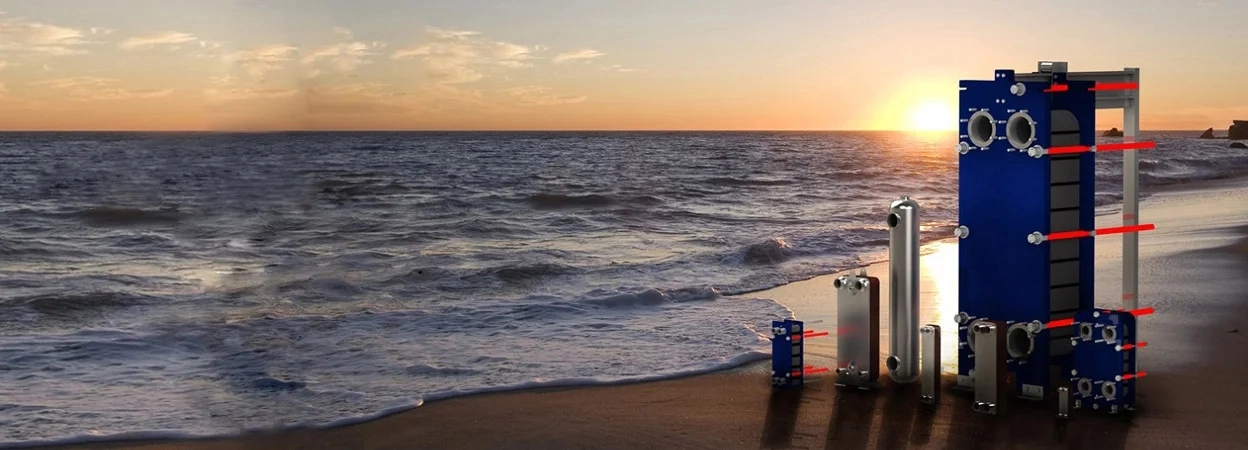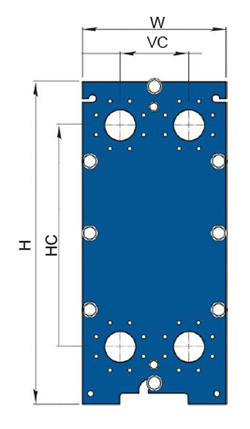Semi-welded GPHE



Semi-weld Plate heat exchanger

What is Semi-weld PHE?
The Semi-weld Plate heat exchanger plates are welded by laser. the laser welding means that metal is melted by a laser beam from a high power laser. The charge is protected by irert gas Additional welding material is not required.
Applications
• Chemicals
• Energy and Utilities
• Food & Beverages
• HVAC& Refrigeration
• Marine and Transportation
• Mining
• Pulp and Paper
• Steel
• Water and Waste treatment
Benefits
• High heat transfer efficiency: due to their large surface area and turbulent flow paths.
• Low risk of leakage: The fully welded channels reduce the risk of leakage and cross-contamination between different fluids.
• Easy maintenance: Semi-welded plate heat exchangers can be easily disassembled and cleaned, allowing for easy maintenance and reduced downtime.
• Versatile: Semi-welded plate heat exchangers can be used in a wide range of applications, including refrigeration and cooling, heating, and HVAC systems.
Features
• Clip-on gasket
• Lifting lug
• Lining
• Lock washer
• Tightening bolt cover
Semi-weld PHE construction


Technical Data
| Material | ||
| Plates | 304/ 316L stainless, Ti | |
| Field Gasket | NBR, EPDM, FKM | |
| Ring Gasket | NBR, EPDM, FKM | |
| Flange connections | Carbon steel, Metal lined: Stainless, Ti | |
| Frame plate | Carbon steel, epoxy painted |
Connections Available

Model | B60MW | B100BW | B150BW | B200BW |
Height. H [mm] | 920 | 1045 | 1484 | 2150 |
Width, W [mm] | 320 | 454 | 650 | 750 |
Max Length, L [mm] | 1445 | 1795 | 3246 | 3250 |
Vertical Port Distance, VC [mm] | 640 | 719 | 1044 | 1478 |
Horizontal Port Distance, HC [mm] | 140 | 225 | 298 | 353 |
Max Temperature [°C] | 180 | 180 | 180 | 180 |
Max Pressure [bar] | 16/20 | 16/20 | 16/20 | 16/20 |
Port Size | DN50/2′ | DN100/4′ | DN150/6′ | DN200/8′ |
Channel depth [mm] | 3 | 2.5 | 2.5 | 2.5 |
Max Water flow rate [kg/s] | 16 | 50 | 80 | 225 |
Semi-welded plate heat exchangers (PHEs) are advanced thermal transfer solutions designed to handle challenging fluids across multiple industries. Unlike fully gasketed PHEs, semi-welded PHEs feature welded plates, providing additional strength and preventing leakage. This unique design makes them highly effective in applications involving aggressive chemicals, high pressures, or temperature-sensitive processes.
In a semi-welded PHE, plates are welded using laser welding. Laser welding offers a high degree of precision by melting the metal plates with focused laser beams without the need for additional welding material. The process ensures durability and reduces the risk of leakage, making semi-welded PHEs ideal for applications requiring reliable heat exchange and fluid separation.
Whether used for cooling, heating, HVAC systems, or refrigeration, semi-welded PHEs offer high heat transfer efficiency, low maintenance, and versatile applications. Their modular design allows for easy disassembly, cleaning, and reconfiguration, ensuring long-lasting performance with minimal downtime.
Applications of Semi-Welded PHEs
Semi-welded plate heat exchangers are used across a wide range of industries where heat exchange, efficiency, and fluid control are essential. Some of the key applications include:
- Chemical Industry: Used for handling aggressive chemicals in heating and cooling processes, providing a safe and leak-free operation.
- Energy and Utilities: Ideal for district heating, power plants, and energy recovery systems to efficiently transfer heat between fluids.
- Food and Beverage Industry: Applied in processes like pasteurization, cooling, and heating where both hygiene and precise temperature control are critical.
- HVAC & Refrigeration: Commonly used in refrigeration systems for cooling and energy-saving heat recovery in large commercial buildings and industrial facilities.
- Marine and Transportation: Used for seawater cooling systems and heat recovery on ships and offshore platforms, thanks to corrosion-resistant material options like titanium.
- Mining and Metal Processing: Helps transfer heat efficiently in ore extraction and metal refining processes.
- Pulp and Paper Industry: Supports energy-efficient heating and cooling during the paper production process.
- Steel Industry: Provides effective heat transfer during steel production and cooling of machinery.
- Water and Waste Treatment: Used for heat recovery and evaporation in wastewater treatment plants to ensure energy-efficient operations.
Benefits of Semi-Welded Plate Heat Exchangers
Semi-welded PHEs offer numerous benefits that make them the preferred choice for demanding industrial applications:
High Heat Transfer Efficiency
The large surface area of the corrugated plates combined with the turbulent flow paths ensures exceptional heat transfer efficiency. Fluids pass over the plates in alternating channels, maximizing the thermal exchange between the two mediums while maintaining compact dimensions.Low Risk of Leakage
The fully welded channels on the fluid side significantly reduce the risk of leakage or cross-contamination between different fluids. This makes semi-welded PHEs suitable for industries handling aggressive chemicals or hazardous materials, where safety is paramount.Easy Maintenance and Serviceability
Semi-welded PHEs are designed to allow easy access for disassembly and cleaning, ensuring minimal downtime. The clip-on gaskets and modular construction make it possible to perform maintenance quickly, helping reduce operational costs.Versatile Applications
These heat exchangers can be adapted for various processes, including refrigeration, cooling, and heating systems. Their ability to handle both corrosive and non-corrosive fluids makes them useful in a broad range of industries, from food production to marine applications.
Key Features of Semi-Welded PHEs
Several design features enhance the performance, reliability, and ease of use of semi-welded PHEs:
- Clip-On Gasket: Gaskets are easy to replace and ensure a tight seal between plates.
- Lifting Lug: Facilitates easy handling and installation during assembly or maintenance.
- Lining: Protects the frame and connections from corrosion, especially when exposed to seawater or chemicals.
- Lock Washer: Ensures secure fastening, preventing the loosening of bolts during operation.
- Tightening Bolt Cover: Provides additional protection to the tightening bolts, reducing wear and tear over time.
Construction and Design of Semi-Welded PHEs
A semi-welded PHE features laser-welded plate pairs, which form sealed channels for one fluid, while the other fluid flows through gasketed channels. This combination provides the benefits of both welded and gasketed designs—the robustness of welding with the flexibility of gaskets. The welded plates prevent leakage of aggressive fluids, while the gasketed channels allow easy access for cleaning and maintenance.
The plates are made from materials like 304 or 316L stainless steel for general applications and titanium (Ti) for corrosive environments. The frame plates are constructed from carbon steel and coated with epoxy paint for added durability.
Technical Data and Materials
- Heat Transfer Plates: 304/316L Stainless Steel, Titanium
- Field Gaskets: NBR (Nitrile), EPDM (Ethylene Propylene Diene Monomer), FKM (Fluorocarbon)
- Ring Gaskets: NBR, EPDM, FKM
- Flange Connections: Carbon steel or metal-lined stainless steel, Titanium
- Frame Plate: Carbon steel with epoxy coating
Available Models and Specifications
The semi-welded PHEs are available in several models, each designed for different capacities and operational needs.
Operational Efficiency and Performance
The semi-welded design allows these PHEs to withstand pressures up to 20 bar and temperatures up to 180°C (356°F), making them suitable for high-demand applications. With port sizes ranging from DN50 to DN200, they can handle high flow rates, making them efficient for large-scale processes. The channel depth varies between 2.5 mm and 3 mm, ensuring optimized fluid flow and minimal pressure drop.
How Semi-Welded PHEs Compare to Other Heat Exchangers
Semi-welded PHEs offer several advantages over traditional heat exchangers, such as shell-and-tube designs. They are more compact, easier to maintain, and provide higher heat transfer efficiency. Additionally, the modular nature of semi-welded PHEs allows for capacity adjustments by adding or removing plates, unlike shell-and-tube systems, which have fixed capacities.
Conclusion
The semi-welded plate heat exchanger (PHE) is an ideal solution for industries requiring high heat transfer efficiency, reliability, and versatility. With a combination of welded and gasketed channels, these PHEs minimize the risk of leakage while ensuring easy maintenance. Their compact design, high flow rates, and ability to withstand extreme temperatures and pressures make them well-suited for energy, chemical, food, marine, and wastewater treatment applications.
At Mge Tech, we offer high-quality semi-welded PHE solutions designed to meet the most demanding operational needs. Our products are built with premium materials like stainless steel and titanium, ensuring durability, efficiency, and cost-effectiveness. Contact us today to learn more about how our semi-welded plate heat exchangers can enhance your processes.
